 |
| Adox Silvermax - left: old style labels/right: current label style |
Earlier this year, out of curiosity, I bought, and shot, a roll of
Adox Silvermax 21. Silvermax is relatively new film, introduced two years ago. That first roll had a label that was inkjet printed, suggestive of a small production run. It was not DX coded and the name Silvermax 21 referred to the film speed expressed in the DIN scale rather than ISO; more recently, the last couple of rolls I've bought were Silvermax 100, still with printed labels and without DX coding, but no longer printed by inkjet. It is currently available in 35mm and also Super 8 as
Adox Pan-X Reverso. According to the
data sheet, Silvermax is a mix of traditional cubic and t-grain crystals, in a single layer emulsion with enhanced silver content, hence the name.
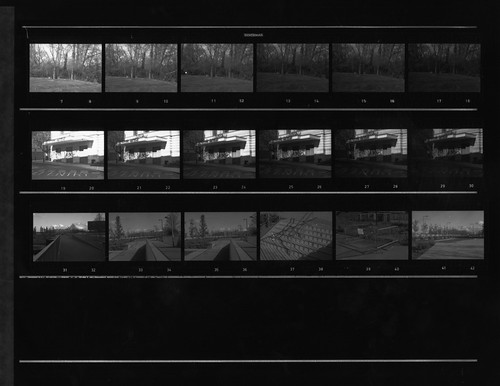 |
| Adox Silvermax latitude test contact sheet |
The roll I'd shot earlier this year had been without any prior testing of the film, but I decided to return to it. As in some of the other film tests posted on this blog, I shot a roll (with an
Olympus OM10) at a variety of exposure indexes to test the film's latitude. The contact sheet of this test is above. The first and second rows of six frames are rated, left to right, 12, 25, 50, 100, 200, 400. The third row was all shot at the box speed of 100 ISO. Incidentally, these negatives appeared low in contrast, and at first glance perhaps indicating underexposure, although these scanned well.The negatives also have a half-frame numbering system: rather than the more normal set of numbers in the film rebate of 1, 1A, 2, 2A and so on, there are two numbers per frame in a continuous series. I developed the film in R09 One Shot (Rodinal) diluted 1+25 for 8 minutes at 20ºC. The contact print was made on Ilford Multigrade RC IV without a Multigrade filter.
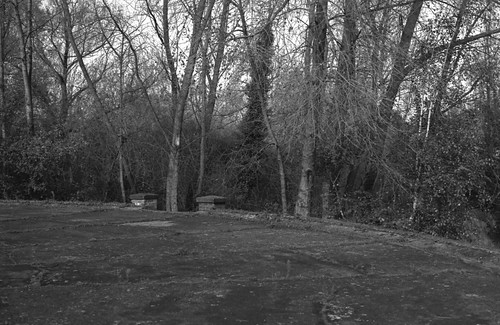 |
| Adox Silvermax at box speed developed in R09 One Shot 1+25 |
I shot two series of images for the latitude test: one of a low contrast subject and one of high contrast, to compare how the film would perform under both conditions. The low contrast subject above was easy to scan without too much adjustment across the whole range of exposures, which would most likely hold true for darkroom printing. The negatives resulting from the high contrast subject were more indicative of the film's capabilities.
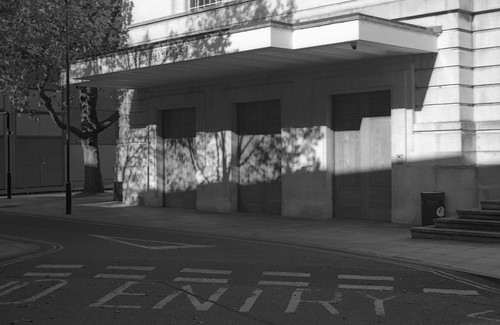 |
| Adox Silvermax at EI 12 (three stops overexposed) |
 |
| Adox Silvermax at EI 400 (two stops underexposed) |
The two images above are exposures separated by
six whole stops. The highlights in the image shot at 12 are not noticeably blocked out, while the shadows in the lower image, although thin, and the tonal range is more compressed, hold detail. In the first row of photographs shown on the contact sheet above, as a lower contrast subject, the difference between each is less. I pulled detail back from both extreme ends of the negatives in the scanning - the film has a clear base, which is designed to aid reversal processing, explicitly mentioned by Adox, but perhaps also to help scanning when developed as negatives. Adox claim 14 zones when developed with their own
propriety Silvermax developer; it would appear that Rodinal or R09 achieves something similar. On the
data sheet for Silvermax, the curve's shoulder has a slow roll over, which, if I am interpreting it correctly, shows that, in the upper range, density builds more slowly as exposure increases, meaning that the highlights resist blocking out. Given the appearance of excellent latitude from the first test, exposing the film at a variety of ratings and
changing the development time to suit should provide even better results. As a relatively new film, there is not a great deal of information on push or pull processing; indeed there are not development times for a wide amount of film developers, although for unlisted developers, Adox recommend using times for (the old version of) Agfa APX 100. From the first test roll that I shot, the film does appear to have relatively prominent grain for its speed, which shows in areas of continuous tone, such as skies like the image below, this may in part be due to the developer used (I haven't used the Silvermax developer for comparison) but also scanning rather than printing can exaggerate the appearance of grain.
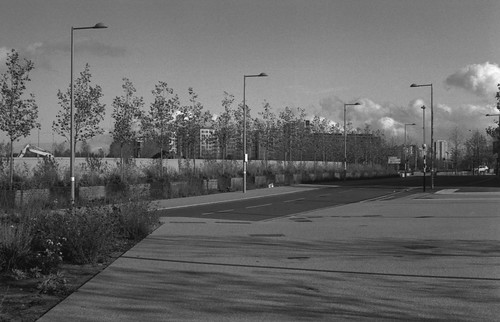 |
| Adox Silvermax at box speed, developed in R09 One Shot 1+25 |
Although recommendations for push and pull processing are few, on the Massive Dev Chart, there is an entry for
rating the film at 80 and semi-stand developing in Rodinal diluted 1:50 for 14 minutes with agitation every three minutes which I wanted to try. The negatives appeared lower in contrast than the roll shot and developed for the latitude test, which was partly the subject matter, but the results had a very pleasant tonality and scanned well. However, rating the film one-third of a stop less and compensating for this a little in the developing is hardly likely to show much of a difference to the standard time and dilution for Rodinal; it may have been a better comparison to shoot at box speed and try Rodinal at 1+50 to see any discernible difference to the dilution of 1+25.
 |
| Adox Silvermax at 80EI semi-stand developed in R09 One Shot 1+50 |
As I have been using Ilfotec LC29 for developing at home, I also wanted to use this with Adox Silvermax and compare it to Rodinal/R09, although the data sheet for the film does not list the developer. For the first roll developed with Ilfotec LC29, I used one hour's
stand development with a dilution of 1+100, as a fairly reliable method when faced with unknown variables.
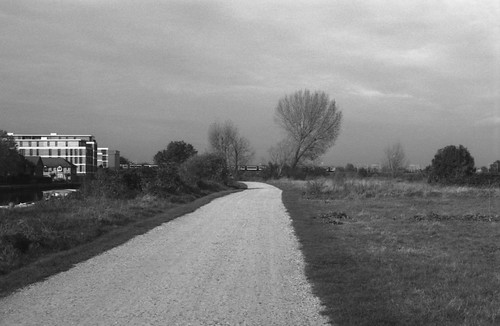 |
| Adox Silvermax at box speed, stand developed in Ilfotec LC29 1+100 |
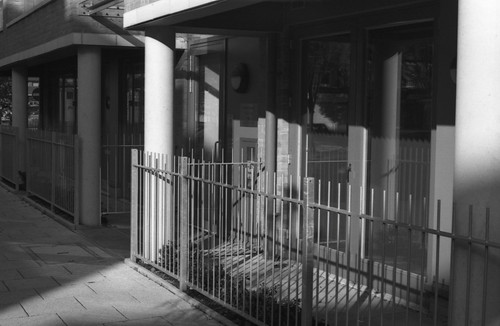 |
| Adox Silvermax at box speed, stand developed in Ilfotec LC29 1+100 |
 |
| Adox Silvermax at box speed, stand developed in Ilfotec LC29 1+100 |
Finally I also tried a one stop push, rating the film at 200. To develop this test, I looked at development times for the old version of Agfa APX 100 in Ilfotec LC29, and extrapolated for one stop of push processing, extending development time from 9 to 14 minutes at 20ºC in Ilfotec LC29, diluted 1+29. As the latitude test suggested, Silvermax coped perfectly well with a small amount of push processing.
 |
| Adox Silvermax rated 200, developed in Ilfotec LC29 1+29, 14m at 20ºC |
 |
| Adox Silvermax rated 200, developed in Ilfotec LC29, 14m at 20ºC |
Of the different development routines, Ilfotec LC29 appeared to provide better results in comparison to Silvermax in Rodinal, and on the limited tests I've done, I preferred the look when stand developed. The
film test on the Massive Dev Chart shows Silvermax in Adox's Silvermax developer giving a little smoother grain appearance, a better proof may be in darkroom printing, the images in this post are all scanned from the negatives.
 |
| Adox Silvermax at box speed, Kodak Retina IIa, developed in R09 One Shot 1+25 |
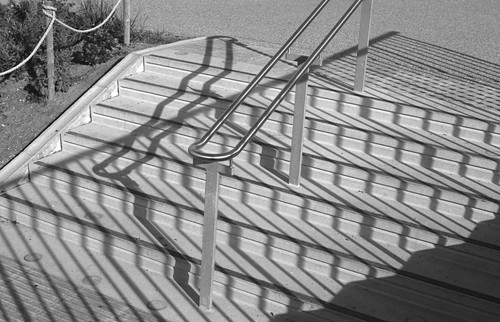 |
| Adox Silvermax at box speed, Olympus OM10, developed in R09 One Shot 1+25 |
 |
| Adox Silvermax at box speed, Olympus OM10, stand developed in Ilfotec LC29 1+100 |
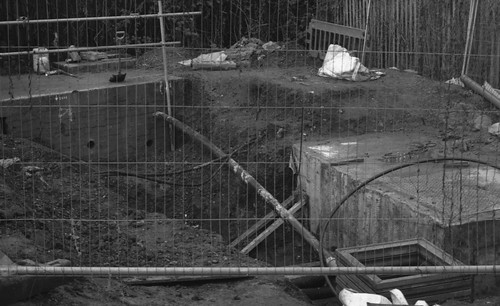 |
| Adox Silvermax at EI 200, Olympus OM10, developed in Ilfotec LC29 1+29 for 14 minutes |
















This comment has been removed by the author.
ReplyDeleteNice work, i find it difficult to translate the scanned results.
ReplyDeletedid some printing today.....EI 100 in FX 39, need some extra tuning to increase contrats/
I exposed this at ISO1600, push processed it two stops by the 25% rule (there is no data available as how to push process this particular emulsion, so I did 17'@20ºC, considering a guy whose results were as good at ISO100 as they were at 400 and he had processed the film as ISO100) as it is a really weird response film. Most of it was exposed at 640, didn't overdevelop. I'm guessing it's due the excess silver, but rather than underexposing, this film seems to change the contrast curve when pushed hard. Grain is barely noticeable @1600, about the same as it is at 100 @640.
ReplyDeleteThanks for your comment; I haven't tried any pushing beyond 200, but I think that looking at its latitude, the film should be good for a couple more stops with the right development no doubt. Perhaps I should revisit Adox Silverman for more tests?
Delete